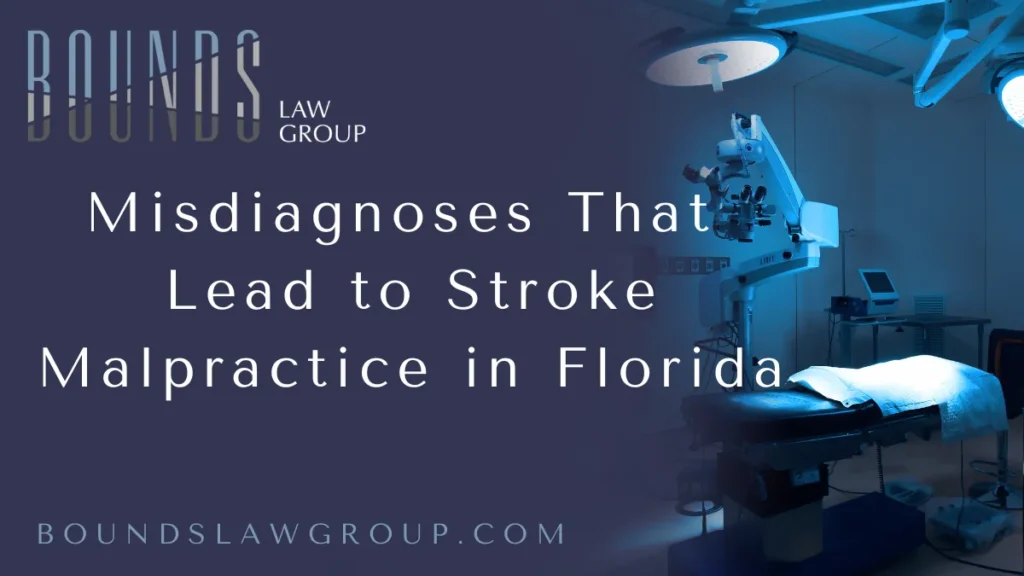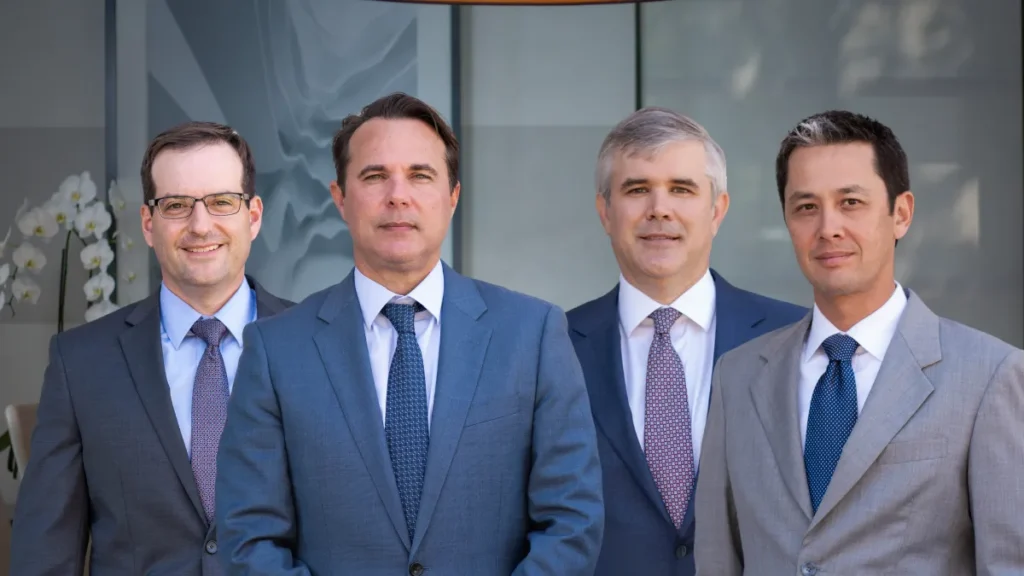
Common Stroke Misdiagnoses in Florida | Bounds Law Group
Stroke is a medical emergency that requires swift and accurate diagnosis to prevent severe consequences, including permanent disability or death. Unfortunately, common stroke misdiagnoses in Florida are all too frequent, leading to devastating outcomes for patients. In many cases, strokes are mistaken for other conditions, such as migraines, vertigo, or diabetic episodes, which delays treatment and exacerbates the damage. When healthcare professionals fail to correctly identify stroke symptoms, the result may be medical malpractice. At Bounds Law Group, we understand the profound impact of these errors and are dedicated to helping victims of stroke misdiagnosis seek justice and compensation. We will explore the most common stroke misdiagnoses, the legal implications of stroke malpractice, and how victims can pursue legal action for their suffering.
Contact us now at 877-644-5122 or complete the free case evaluation form for expert legal assistance.
Common Stroke Misdiagnoses Florida Physicians Make
Not every stroke presents the same way. While classic symptoms include sudden numbness, confusion, vision problems, dizziness, and loss of coordination, not all patients exhibit every sign. This leads to misdiagnoses that delay vital treatment such as tPA (tissue plasminogen activator), which must be administered within a short therapeutic window.
Here are the most frequent misdiagnoses associated with strokes in Florida hospitals:
1. Vertigo or Inner Ear Disorders
Dizziness and imbalance, common in strokes, are often mistaken for benign conditions like vertigo, labyrinthitis, or Meniere’s disease. Emergency room doctors may dismiss these symptoms without proper neurological exams or imaging.
2. Migraine Headaches
A hemiplegic migraine can mirror stroke symptoms, including visual disturbances and one-sided weakness. Without a full neurological workup, physicians in Florida’s ERs and urgent care centers may wrongfully conclude it’s "just a migraine."
3. Hypoglycemia or Hyperglycemia
Low or high blood sugar levels can cause confusion, slurred speech, and even seizures—leading to misclassification of a stroke as a diabetic episode. The failure to check glucose levels with simultaneous imaging is a common diagnostic pitfall.
4. Seizure or Postictal State
Following a seizure, a patient may experience Todd’s paralysis, a temporary post-seizure weakness that mimics a stroke. Misidentifying this condition and failing to investigate further with a CT scan or MRI is a frequent issue in Florida emergency rooms.
5. Intoxication or Substance Abuse
Patients exhibiting disorientation, slurred speech, and poor coordination are too often assumed to be intoxicated, especially if they have a history of alcohol or drug use. This dangerous assumption can cause catastrophic delays in stroke intervention.

How Stroke Misdiagnosis Constitutes Medical Malpractice in Florida
Medical professionals are held to a standard of care that requires diligence in assessing stroke risk and symptoms. When that standard is breached, and a stroke goes undiagnosed or misdiagnosed, it may constitute medical malpractice.
To prove malpractice in a Florida stroke misdiagnosis case, we must demonstrate:
- A provider-patient relationship existed.
- The provider failed to meet the standard of care.
- That failure directly led to injury or death.
- Damages, such as long-term disability, financial loss, or emotional trauma, occurred.
At Bounds Law Group, we work with leading neurologists, radiologists, and emergency medicine experts to build a compelling case that illustrates how a misdiagnosis occurred and what consequences followed.
Why Stroke Must Be Diagnosed Promptly in Florida Healthcare Settings
Stroke treatment is a race against time. The brain loses nearly 2 million neurons each minute during an ischemic stroke. Administering tPA or performing thrombectomy within a narrow window (often 3–4.5 hours for tPA) can mean the difference between full recovery and permanent paralysis or death.
When medical staff in Florida’s hospitals and clinics fail to:
- Order a non-contrast CT scan or MRI
- Conduct a full neurological exam
- Take proper patient history
- Consult with a neurologist or stroke specialist
...they risk violating the standard of care, especially when dealing with patients who present with symptoms aligned with common stroke misdiagnoses Florida sees regularly.
Emergency Room Negligence and Stroke Misdiagnosis Trends in Florida
Data shows that younger patients, women, and minorities are disproportionately affected by stroke misdiagnoses. Many ERs operate on overloaded schedules, pushing doctors to make snap judgments without adequate testing. As a result, patients may be discharged or misdiagnosed with a non-neurological condition, only to suffer severe strokes hours or days later.
Bounds Law Group has represented numerous clients across Florida whose strokes were either missed completely or treated too late. These cases are not only tragic but preventable. We believe that holding negligent providers accountable is essential for safer care systems.
Legal Options After a Stroke Misdiagnosis in Florida
If you or a loved one has suffered due to a common stroke misdiagnoses Florida medical professionals made, you may be entitled to compensation for:
- Medical expenses
- Rehabilitation and physical therapy
- Lost wages and loss of earning capacity
- Pain and suffering
- Wrongful death damages (if applicable)
We encourage all victims or their families to complete the free case evaluation form or call us now at 877-644-5122 for a confidential consultation. There is no fee unless we recover compensation on your behalf.
Why Choose Bounds Law Group for Your Stroke Malpractice Case
At Bounds Law Group, we specialize in complex medical malpractice litigation, with a focus on stroke misdiagnosis cases across Florida. Our team brings together decades of legal experience, aggressive investigation techniques, and a compassionate approach to client care.
We don’t just take on cases—we fight to change lives, expose systemic errors, and seek justice where it’s due. Our results speak for themselves, and our commitment to excellence has helped families reclaim hope and financial security after devastating medical errors.
The Role of Diagnostic Imaging in Preventing Stroke Misdiagnosis in Florida
One of the most critical tools in identifying a stroke is diagnostic imaging. Early and accurate imaging can dramatically reduce the likelihood of a stroke misdiagnosis in Florida hospitals. However, failures in properly utilizing diagnostic tests or interpreting their results are major contributors to medical malpractice in stroke cases.
The Importance of CT Scans and MRIs in Stroke Diagnosis
When a patient presents with stroke-like symptoms, the first line of diagnostic testing is typically a non-contrast CT scan or an MRI of the brain. These imaging tools allow medical professionals to:
- Identify signs of ischemic stroke (caused by a blockage of blood flow) and hemorrhagic stroke (caused by bleeding in the brain).
- Differentiate between stroke and other conditions, such as migraines, seizures, or vestibular disorders that may mimic stroke symptoms.
- Detect brain damage or other underlying conditions, which may not be immediately visible through a basic physical examination.
Failing to promptly order or properly interpret these scans can result in a stroke misdiagnosis, leading to critical delays in treatment. A delay in administering tPA (tissue plasminogen activator) for ischemic strokes, for example, can result in irreversible brain damage. For hemorrhagic strokes, immediate intervention is required to control the bleeding, and failure to act quickly can be fatal.
Challenges in Imaging and Stroke Diagnosis
While imaging is essential, its effectiveness depends on multiple factors:
- Inexperienced Radiologists: A lack of expertise or failure to notice subtle changes in imaging results can lead to missed strokes.
- Misinterpretation of Scan Results: Even a skilled radiologist may misinterpret CT or MRI images, mistaking a stroke for another condition with similar symptoms.
- Patient Factors: Certain patient conditions, such as obesity, metallic implants, or claustrophobia, may hinder the use of diagnostic imaging and lead to missed diagnoses.
In some cases, Florida hospitals may fail to follow up on initial imaging results, overlooking subtle stroke symptoms or not conducting additional tests to rule out other causes. This negligence can have devastating consequences for the patient’s health and recovery.

How Bounds Law Group Helps in Stroke Imaging Malpractice Cases
At Bounds Law Group, we have access to top-tier medical experts who can help identify lapses in diagnostic imaging during the stroke diagnosis process. We work closely with radiologists, neurologists, and other medical specialists to ensure that proper diagnostic tests were performed and correctly interpreted. If imaging mistakes or delays occurred, we hold negligent healthcare providers accountable for the harm caused.
By addressing these crucial diagnostic imaging failures, we aim to ensure that patients receive the timely and appropriate care they need to recover from a stroke. If you or a loved one has experienced a stroke misdiagnosis due to errors in imaging, please complete the free case evaluation form or call us now at 877-644-5122 for a confidential consultation.
Sources
- National Institute of Neurological Disorders and Stroke (NINDS)
A trusted resource offering comprehensive information about strokes, their symptoms, and treatment guidelines.
https://www.ninds.nih.gov - American Heart Association – Stroke Guidelines
This source provides up-to-date research and professional guidance on diagnosing and managing strokes.
https://www.stroke.org - Johns Hopkins Medicine – Stroke Diagnosis and Treatment
A medically reviewed overview of stroke types, diagnostic errors, and misdiagnosis implications.
https://www.hopkinsmedicine.org/health/conditions-and-diseases/stroke

